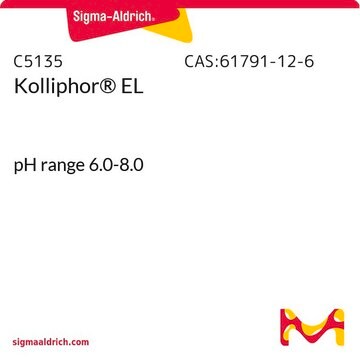50246
Poli(etilenglicol)-bloque-poli(propilenglicol)-bloque-poli(etilenglicol))
Sinónimos:
Poly(ethylene glycol)-block-poly(propylene glycol)-block-poly(ethylene glycol), Lμtrol micro 127
About This Item
Productos recomendados
mol peso
~9840-14600 g/mol
Nivel de calidad
composición
oxyethylene content, 71.5-74.9%
impurezas
≤0.25% ethylene glycol and diethylene glycol
≤0.4% total ash
≤0.75% water
≤1 ppm ethylene oxide
≤2 ppm arsenic
≤20 ppm heavy metals
50-125 ppm butylhydroxytoluene
residuo de ign.
≤0.30%
color
APHA: ≤120
Distribución del tamaño de partículas
, coeff var ≤10% (residue, No. 140 USS)
, coeff var ≤50% (residue, No. 270 USS)
pH
5.0-7.5(1:10)
5.0-7.5(1:40)
idoneidad
complies for Infrared spectrum
InChI
1S/C3H6O.C2H4O/c1-3-2-4-3;1-2-3-1/h3H,2H2,1H3;1-2H2
Clave InChI
RVGRUAULSDPKGF-UHFFFAOYSA-N
¿Está buscando productos similares? Visita Guía de comparación de productos
Categorías relacionadas
Aplicación
Nota de análisis
1,4-dioxane ≤5 ppm, ethylene glycol ≤620 ppm ( verified on random samples only)
Otras notas
Información legal
Código de clase de almacenamiento
11 - Combustible Solids
Clase de riesgo para el agua (WGK)
WGK 3
Punto de inflamabilidad (°F)
Not applicable
Punto de inflamabilidad (°C)
Not applicable
Certificados de análisis (COA)
Busque Certificados de análisis (COA) introduciendo el número de lote del producto. Los números de lote se encuentran en la etiqueta del producto después de las palabras «Lot» o «Batch»
¿Ya tiene este producto?
Encuentre la documentación para los productos que ha comprado recientemente en la Biblioteca de documentos.
Los clientes también vieron
Nuestro equipo de científicos tiene experiencia en todas las áreas de investigación: Ciencias de la vida, Ciencia de los materiales, Síntesis química, Cromatografía, Analítica y muchas otras.
Póngase en contacto con el Servicio técnico






